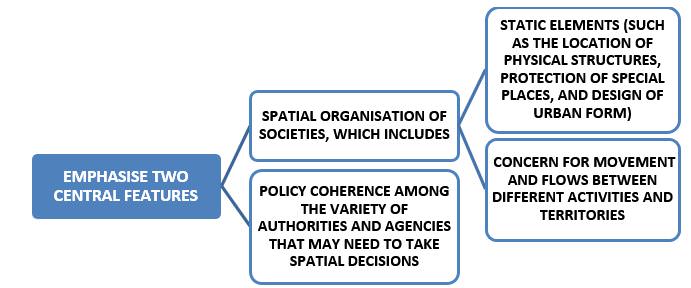Spatial Planning
Spatial planning is the consideration of what can and should happen where. It investigates the interaction of different policies and practice across regional space, and sets the role of places in a wider context. It goes well beyond ‘traditional’ land-use planning and sets out a strategic framework to guide future development and policy interventions. It deals with the optimal location of people, goods and services in a specific area. It focuses on organization, arrangement and infrastructure of a specific area to achieve better living standards of its residents. Spatial planning aims at achieving complementarity between micro/local level planning and macro level planning.
Spatial planning refers to the methods used by the public sector to influence the distribution of people and activities in spaces of various scales (Wikipedia). Spatial planning is treated as the strategic determination and spatial allocation of land – uses at the metropolitan scale according to Dodson (2009) or as Healey et al. (1999:341) have termed it, ‘a set of governance practices for developing and implementing strategies, plans, policies, and projects, and for regulating the location, timing, and form of development’.
Tiwari in his book, “Regional Development and Planning in India, points out that spatial planning is referred to as the locational planning or the systematic planning of locations in space, in a given region. Thus, the main objective of spatial planning is to formulate a location – allocation strategy for guiding new investment on various services and activities at appropriate locations to ensure equitable and efficient spatial distribution. He further elaborates that spatial planning is a systematic process of locating things and people where they can be used or act most effectively to achieve accepted purpose or goal. In brief spatial planning is concerned with location – allocation decision – making or with selecting suitable human activities for given locations and appropriate locations for certain selected activities. This can also be put as, selecting ‘things for places and places for things’ are the essence of spatial planning. The main task of spatial planning, therefore, is to evolve a functionally coherent hierarchical spatial strategy to locate things and people where they can be used or act most effectively to achieve certain objectives.
Definitions of spatial planning tend to emphasise two central features (Tewdwr-Jones & Williams, 2001; Healey, 2004; Scho¨ n, 2005). The first relates to the spatial organisation of societies. This includes both static elements (such as the location of physical structures, protection of special places, and design of urban form) and a concern for movement and flows between different activities and territories. The second relates to policy coherence among the variety of authorities and agencies that may need to take spatial decisions.

Objective of Spatial Planning:
The main objective of Spatial Planning is to generate a process of spatial development which:
- optimizes utilization of resources,
- reduces regional, spatial and economic imbalances,
- strengthens urban and rural relationships,
- improves the quality of life of the majority of the people,
- protects the environment and maintains an ecological balance.
Spatial Integration
Spatial Integration signifies integration of various entities relevant to planning such as land uses, planning institutions, and stakeholders. It expresses the opportunities for and level of interaction within and between areas and may reflect the willingness to cooperate. For example, the levels of connectivity between transport systems of different geographical scales. It can be deployed as a mechanism to devise efficient spatial planning policies.
Thus interactions and willingness to cooperate between people and areas have to be central to successful spatial integration. Resolutions to problems could be found by integrating policies of one region with the other region. For example, transport problems of CNCR get resolved only through interaction and cooperation among the states of Delhi, U.P., Haryana and Rajasthan.
Due to the fragmentation and multiplicity of governing structures & institutions, there is an urgency to address the issue of integration of policies and development plans along with integration of institutions working at local level.
Need for spatial integration:
Development plans prepared at various levels, i.e., national, state, region, sub-region, district, block, village and urban areas, need integration.
Convergence of various agencies responsible for preparation and implementation of these plans, convergence of policies and sectors, and convergence of interstate development plans also falls within the scope of spatial integration.
There is a sequence of steps for preparation and implementation of any development plan from the statement of objectives to monitoring and feedback. Integration of one step with the other is necessary.
Collaborative planning theory lays implicit emphasis on integration of various discourses through ‘communicative reasoning’. Different worldviews are to be integrated rather than one to be prioritized over others because all viewpoints are regarded equally important and worthy of consideration in the process of public argumentation. Thus spatial integration requires governance of different arenas, times, places and sectors ensure its realization.
Disclaimer: This article forms a part of report made by students of School of Planning & Architecture, New Delhi. The content published is not owned by Planning Tank and belongs to it’s author. It was submitted by one of our user and provided for educational purpose only.